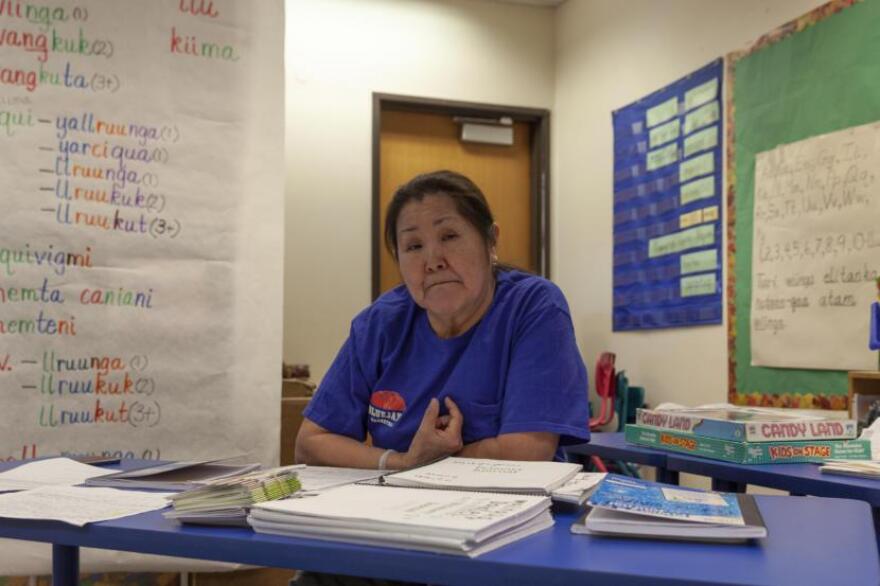On a warm, sunny day in the village of Tuntutuliak, a group of children run around each other on a boardwalk outside of the bright blue building that houses the village’s K-12 school.
Their shouting is a blend of Yugtun and English.
That blend of languages is mirrored inside the school. Small, flippable signs hang on the outside of each classroom door. They designate the language of the day. Some days it is English. Others it’s Yugtun.
In Alice Fitka’s class, it’s always Yugtun.
Walk in the door of her classroom, and you’re greeted with an explosion of colors, numbers and letters: Letters of the alphabet are strung above the whiteboards and colorful posters decorate the walls. Behind Fitka’s desk is a large poster of the Yugtun alphabet and the numbers 1-10 — Fitka sings both to the familiar tune of “Twinkle Twinkle Little Star.”
It’s in this classroom where kindergartners and first graders in the Western Alaska village of Tuntutuliak learn their Yup’ik language. They get their grammar, along with a healthy dose of life lessons and cultural knowledge from Fitka.
Fitka, 62, has been teaching Yugtun in the village school for 37 years.
Just a few turns away on the wooden boardwalk that snakes through town, right along the edge of the Tagayarak River, is a decrepit, abandoned building that used to be another school. This one was run by the Bureau of Indian Affairs.
Fitka remembers a lot of things about that school. She remembers that it was not big enough to have a cafeteria, so the students pulled boards down from the walls and ate in the hallways. She also remembers a completely different experience with her Native language when she was a kindergartner in the 1960s.
She picks up a ruler from a nearby corner and looks at it, turning it over a few times.
“My hands would be hit with a wooden ruler,” she said. She gives her palms a few sharp slaps demonstrate. The jarring sound reverberates throughout her classroom.
Each time she broke the rules and used Yugtun, the teacher would write a mark next to her name on the board. Too many marks and she was punished.
Many Alaska Native children were punished for speaking their Native languages — an outgrowth of a U.S. educational policy designed to assimilate Indigenous children into Western culture and a different way of thinking.
When Fitka talks about it, her voice still breaks.
“Being treated like that, you know, for being hit on my hands for the first time in my life at 5 years old, having never been hit in your life. You know, that’s traumatic.”
It was hard, but she started with survival English at first. “You know, ‘Can I use the bathroom?’ ‘Can I drink some water?'”
But, Fitka said, she considers herself lucky, because her parents didn’t speak any English.
“Had they known English, and had they known that I was being punished at school, I think they would have spoken to me only in English,” she said.
Now she can pass along her language — and everything that comes with it — to her students.
But she sees trouble ahead.
Central Alaskan Yup’ik — that’s the dialect spoken in the Fitka’s area of the Lower Kuskokwim River — is the most widely spoken of the state’s Native languages, according to the Alaska Native Language Center at the University of Alaska Fairbanks.
But there has been a decline in the number of fluent speakers. That drop can be seen throughout the state. Data from the Alaska Native Language Preservation and Advisory Council shows there are simply fewer people in the state speaking Indigenous languages fluently.
In the last decade or so, Fitka noticed a shift in her young students: More of them are speaking English at home.
“I feel very sad that nowadays there are some young couples in the village here — that I have taught, you know, they are fluent in their Yup’ik language. They teach their kids to speak only English,” she said.
Fitka said that thinking in Yugtun and thinking in English are not the same.
She tells the story of an Elder in the village who used to come sit in her classroom.
“He used to like to come in and just sit down and just watch me with my students,” she said.
He asked her if she watched the kids who speak English at home and those who speak Yugtun. He told her they act differently.
“Now that I’m over the hill, you know, I can see it. The kids that are fluent in their first language, it’s like they’re more aware,” Fitka said.
Each morning, when the children come into the classroom to see her, the ones who are fluent in Yugtun — who speak it at home and are immersed in the language and the culture — speak to her differently.
“They’ll come in, and they’ll tell me in Yugtun what the weather is like out there,” Fitka said. “And that’s what the Elders did a long time ago. That’s what they used to ask the little kids when they came in after being out. It taught you to be aware of your surroundings.”
She worries that if the Yugtun language isn’t passed along, children will lose touch with their cultural heritage too.
“Our language is like a rope, you know, and if you look at a rope, if you take it apart, it has many strands in there, you know. It’s what makes it strong. If it was just a little skinny strand, it can’t pull a sled, it can’t tie a boat down. And our language is like that rope, you know. It has how to raise a child. It tells us how to be. How to preserve food, how to prepare food. All in Yup’ik.”



